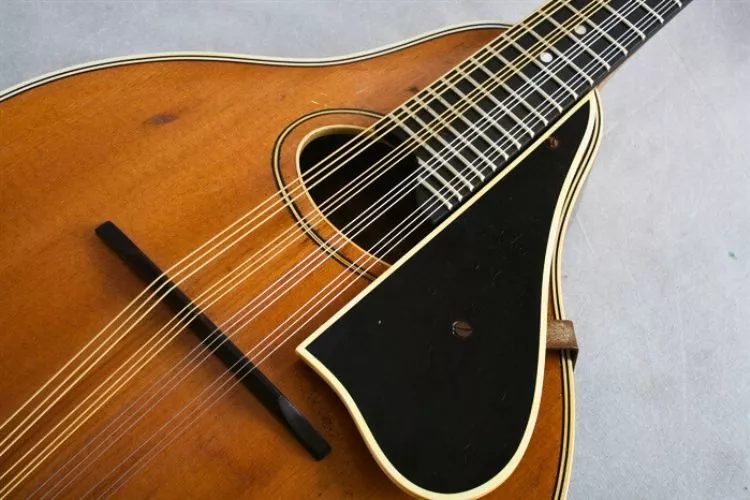The mandolin has etched an important and distinctive niche by offering a unique blend of melodic charm and harmonic complexity.
Despite its popularity among seasoned musicians and music lovers, one question often arises: “how many strings does a mandolin have?”

In this article, I will not only answer the question but also take you through the intricacies of how the number of strings impacts the sound and versatility of the mandolin.
Contents
🎶How many strings does a mandolin have?
A mandolin typically has eight strings arranged in four courses or pairs. Each pair of strings is tuned in unison and usually corresponds to four distinct pitches, mirroring the tuning of a violin: G3, D4, A4, and E5.
While the eight-string mandolin is the most common, there are variations with more courses, depending on historical or stylistic preferences.
This grouping of paired strings allows the mandolin to produce its distinctive rich, warm, and resonant tone.
When a pair is plucked or strummed, the closely tuned strings vibrate sympathetically, creating a chorus effect that enhances the sustain and volume of the note. This characteristic makes the mandolin perfect for both solo performances and as part of ensembles.
Furthermore, the tuning familiarity of the mandolin to the violin lends ease to cross-instrumentalists, allowing them to switch between the two instruments without much reorientation of fingerings.
Indeed, the blend of paired strings contributes greatly to the mandolin’s musical charm.
🎶What is a 12 string mandolin called?
A mandolin with 12 strings is frequently called a Mandriola, sometimes called a 12-string mandolin.
Unlike the typical mandolin with 8 strings arranged in four courses or pairs, the Mandriola features 12 strings in six triple courses.

This layout adds to the instrument’s tonal richness and dynamic range. Each course is tuned in unison, played simultaneously, and follows the same tuning order as a conventional mandolin: G, D, A, and E.
The additional two courses, usually placed as the third and fourth, can be tuned variably depending on the player’s preference.
Mostly used in Europe, especially in German-speaking regions, the Mandriola is not as globally mainstream as the 8-string mandolin but is admired for its distinct sound.
🎶What is the difference between a mandolin and a Mandriola?
While the mandolin and Mandriola share a common lineage, key distinctions exist between the instruments regarding their structure and sound.
The standard mandolin features eight strings arranged in four courses or pairs, emulating the exact tuning of a violin (G, D, A, E). This structure provides a crisp, vibrant tone that lends itself well to various musical genres.
On the other hand, the Mandriola, also known as a 12-string mandolin, has a different layout. It has 12 strings organized into six triple courses with two additional courses between the A and D and D and G courses.
This unique arrangement adds to the instrument’s tonal richness, giving it a denser, resonant sonic output.
Despite these variations in string configuration, both instruments retain the mandolin family’s quintessential ‘teardrop’ body shape. However, the choice between them primarily hinges on the player’s musical demands or stylistic preference.
🎶What are the 2 styles of mandolin?
When categorizing mandolins into two primary categories, the most universally-accepted distinction would be between the ‘Neapolitan’ or ‘bowl-back’ style and the ‘American’ style, further divided into the ‘A’ and ‘F’ styles.

The Neapolitan, or Italian style, also referred to as the ‘bowl-back,’ ’round-back,’ or ‘tater-bug,’ features a bowl-shaped back constructed of multiple strips of wood.
Developed in Naples, Italy, it’s known for having a mellow, sweet tone suitable for classical, folk, and early mandolin orchestra music.
The American style, birthed in the United States during the 20th century, is divided into two main types – the ‘A’ and ‘F’ styles.
The ‘A’ style is characterized by a teardrop or pear-shaped body and traditionally a unique oval sound hole, referred to as the ‘Oval’ type. Its tone is warm and round, ideal for folk, Celtic, and old-time music.
The ‘F’ style mandolins have a more ornate, curvier body and scrolled upper bout. They are typically equipped with f-shaped sound holes, similar to those found on a violin.
Primarily utilized for bluegrass and country music, ‘F’ style mandolins are admired for their bright, crisp, and loud sound.
Conclusion:
Understanding the number of strings a mandolin has and how they are arranged is crucial to grasp the instrument’s unique sound and playing technique.
With its most common version encompassing eight strings arranged in four pairs, the mandolin flaunts a distinctive tonal richness that numerous musical genres have embraced.
Variations like the Mandriola with twelve strings further exemplify the instrument’s adaptability and versatility.
The mandolin’s complex world is a testament to human creativity and our ceaseless pursuit of expressive sound.
Whether you are a musician, a luthier, or a music lover, we hope that this exploration into the mandolin’s strings has deepened your appreciation for this remarkable instrument and its compelling symphony that continues to resonate through time.
